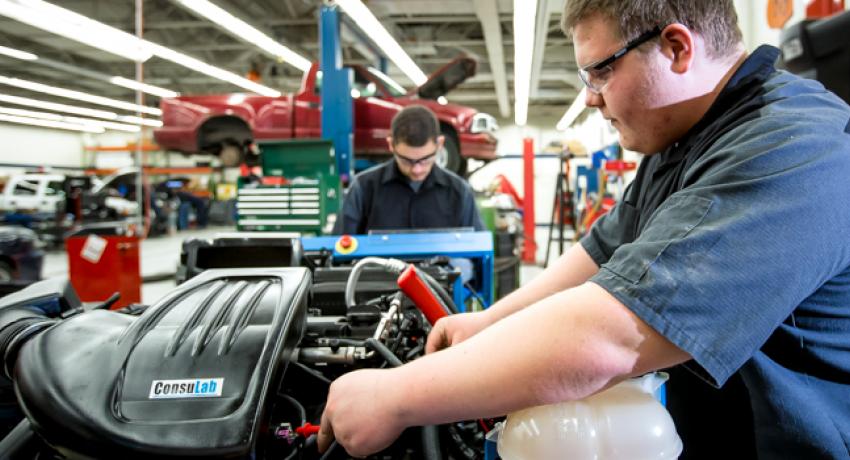At the 1939 World’s Fair in New York City, General Motors had an exhibit called “Futurama.” This was a model of the future that showed how we could have automated vehicles and highways that reduce traffic congestion and vehicle accidents. At the 2019 North American International Auto Show in Detroit, 29 vehicle manufactures were present and all of them showcased their version and vision of a fully autonomous vehicle and infrastructure.
Today, every vehicle manufacture has some version of autonomous technology implemented. From the simplest systems that use ultrasonic distance sensors to detect and alert the driver that they are about to backup into a tree; to vehicles that use light sensors, ultrasonic sensors, cameras, LIDAR, radar, GPS, live traffic data, and vehicle-to-vehicle data transferring to fully drive, accelerate, and brake a vehicle down an interstate or through inner-city congested traffic without human interaction.
In today’s world, every transportation occupation is affected. Tractors have been driving themselves using GPS and field mapping for more than a decade, bulldozers can grade a surface to finish grade without driver intervention, airplanes can fly and perform missions on the other side of the world from North Dakota, submarines can dive to depths where there isn’t any light and use sensors to map underwater boat wrecks, boats can follow a contour line or predetermined route while the driver uses both hands and their entire attention to fish, vehicles can safely stop and turn by themselves when they predict that an accident will occur, and a car can retrieve itself in a parking lot using valet mode to pick you up at the front door of the hotel.
So, what does that mean for the workforce? How do these rapid changes in technology change what education has to do?
FOR EDUCATORS
The challenge to educators is to implement or blend new curriculum into existing programs. Largely focusing on electrical/electronic systems and sensors, as well as the logic and features of autonomous vehicles. It also means that educators will have to partner with employers to perform outreach to the multitude of careers with autonomous technology. Between the time an 8th grade student goes to a career fair and the day they graduate from college autonomous technologies will have changed and evolved more than any other technology has in history. This is not only a transformative time in transportation, but it is revolutionary.
It also creates an opportunity to be inclusive to other technical programs that are traditionally not related to transportation. Program such as computer science, engineering, robotics, and software programming need to be included in the discussion to bring in expertise and convert a student’s interest in those programs to real-world careers in the transportation industry.
Educators also have the challenge of adapting this technology into programs and curriculum at a rapid pace to match the pace of adoption of the technology in the real world. The most important change to education will be emphasizing the electrical/electronic systems and computer diagnostics components.
FOR EMPLOYERS
The challenge to employers is to find ways to partner with educators to help them gain access to the technology and repair information systems needed to teach the technology. An emphasis on high quality partnerships will be needed by employers to attract students into careers with them. Existing successful models will have to be utilized at a greater rate. A few examples of quality employer/educator partnerships that result in a qualified workforce are internships/apprenticeships, youth career exploration, concurrent enrollment, youth job shadowing, technology and information sharing, and dynamic advisory committees.
Dynamic and working advisory committees are the key place for these activities to start. Good partnerships are created as a result of good relationships. Business survival relies heavily on good forecasting. Being an integral part of the building of your own workforce is one of the key components to successful workplace fulfillment. In the transportation sector, this typically means having employees who can diagnose, service, maintain, repair, sell, manage, and provide customer service to clients/customers.
Greek philosophers said that change is the only constant. That is completely true with the most rapidly increasing/changing technology to ever hit the transportation sector. The only thing that employers can do is to partner and create relationships and programs with educators to stay abreast of changes and be able to react because of that knowledge.
CHANGES TO THE WORKFORCE AND LABOR MARKET
Automation usually is referred to an intentional reduction in the workforce. This is not the case of autonomous vehicle implementation. Autonomous vehicle implementation is about increasing the safety and efficiency of the operation/operator as well as traffic systems. The changes to the workforce will be most felt in the increased need for a higher skills (quality), rather than a reduction in quantity.
In some cases, a severe and chronic workforce shortage may finally have a partial solution. In the trucking industry, autonomous vehicle technology will be a part of the solution to keeping freight on-time, safe, and affordable by solving some of the challenges with 100% human operation. This also relates to other (non-truck driving) jobs where driving is the profession. In these occupations, jobs will eventually be less, but opportunities exist to upskill these professions with relationship to the technology. The loss/creation/change in jobs because of autonomous technologies in vehicles is being studied right now, but appears in the near future to favor an increase in skilled jobs and a decrease in non- or low-skilled jobs. The technology will also change the way society works and travels, but that is a whole other topic for another day.
While government entities are working to increase safety standards, partnering with industry to develop common platforms and structures, and reducing policy uncertainty – workforce agencies and organizations are trying to digest it all and figure out how to transform education and training to prepare students for careers.
Autonomous vehicles will increase safety and improve mobility for communities. This results in increased economic and workforce activity and development. That is something that we can all agree on. However, the implementation and adaption of the technology from manufactures and dealerships will be limited if the workforce is not prepared.
Most of the changes to the workforce will be a result of changes within existing careers and jobs. A limited number of brand new jobs/careers will be created. The majority of these changes are related to the role of the service technician.
Service technicians will have to diagnose, maintain, repair, and update vehicles with increased complexity. A deeper understanding and application of electrical and electronic systems will be an absolute.
Just touching the surface, here are some examples of the specific changes to a few of the occupations in the transportation sector. Automotive and Truck Service Technicians will diagnose issues, repair/replace components, align sensors, and update software. Collision repair technicians will repair/replace, apply paint cover, and reprogram systems. Trucking company logistic controllers and dispatchers will be designing routes for truck platooning. Equipment operators will need additional training on specific computer control GPS systems that control the machine and make it more precise. Service consultants and technicians will be dealing with vehicle cyber security issues. And, all technicians will need to know computer control operations and repairs, as well as computer-to-computer interaction and language.
Evidence from education advisory committees suggests that employers need students completing transportation programs with an increased amount of electrical/electronic knowledge, application, and ability. They note that as the technology continues to increase exponentially, students will need to have a great foundational understanding of electrical/electronic systems to adapt to unforeseen changes in technology many years after they complete a program and move into more matured phases of their career.
Currently, there really isn’t a job title that says “autonomous vehicle technician.” Rather, we have to look the current jobs of technicians, where the skills are embedded. Looking at the supply and demand of technicians shows that there is more demand than supply.
Education program accrediting institutions and industry certifications are changing as well. The National Institute for Automotive Service for Excellence (ASE) is already convening industry experts to design individual certifications in Advanced Driver Assistance Systems (ADAS) as well as planning for changes to school program accreditation.
The true change to the workforce is to realize that autonomous technologies, employment, workforce development, and economic development are interlaced with educational program development. Those who can recognize gains now as early adapters will be those who see economic/workforce activity gains.


